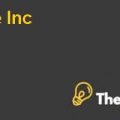
Introduction
Scientific Glass, Inc. (SG) established in 1992 is a midsize player in a specialized glassware industry providing specialized laboratory and research facilities. SG is a fast growing organization with annual sales of $86.3 million for the year ending 2009. The company’s existing market regions include North America, Europe, Asia Pacific and Rest of the World. The industry that SG operates forecasts a robust annual sales growth of 3%-5%. SG faces formidable large equipment providers along with low-end competitors which act has impediment to the company’s growth.
To manage the surplus inventory and fund the expansion plans extra capital is stuck. In this case effective inventory management strategies have been demanded without any extra capital requirement. Different strategies have been introduced such as adding a domestic sales force team to control holding cost of inventory, improve the customer responsiveness to control the fill rate (Time spends to fulfill the new order). The challenges related to order processing and inventory control are discussed in this case.
Problems Statement
- The company’s compensation program to achieve 99% customer fill rate made most of the warehouse managers to keep higher inventory levels than required. The policy of 99% fill rate is a point to be considered while 92% being the industry standard. Moreover, the company’s inventory control policies, not to exceed 60 days' supply are also regularly violated. All these aspects are affecting the companies plan for international expansions and company’s target debt to capital ratios are increased to 40%.
- A centralized inventory monitoring and recording system at Waltham warehouse was not enough to capture the inaccuracies caused by damaged, lost, and stolen goods, human errors led to the mismatch between the computer generated record and the actual inventory. Salespeople regularly asked warehouse managers to perform manual inventory checks, but the time required to track it down, and the time and cost of the inter-warehouse transfer, absorbed much of the profit from the sale.
Addressing the Problems
The above-mentioned issues can be addressed in two major ways. First to restructure the logistics and supply chain by changing the number of warehouse functions, and secondly by implementing the proposed policy changes.
Changing Warehousing Functions
The inventory issues can be handled by changing warehousing functions and the options given in the case are:
ü Centralizing the Warehousing Function: In this option, the company can maintain a centralized warehouse near the manufacturing site near Waltham and serve the customer orders from all the regions.
ü Two centralized Warehouses: With two warehouse's option, SG can think of pooling the order from east and west separately by adding one warehouse in west in addition to the current warehouse in Waltham, which is located in east. The demands in the central part can be pooled from these two warehouses independently.
ü Maintaining the current eight Warehouses: With this option of eight warehouses, each warehouse will be responding to the demand in its region independent of all the other warehouses.
ü Outsourcing the Warehousing functions: In this option, SG can outsource the distribution function to Global Logistics (GL), who provides delivery services that included centralized warehouses in Atlanta.
Evaluating the Options
Based on the data provided in Exhibit 3 & 5 the transportation costs, average inventory levels and the fill rate for the proposed options were as follows:
(The detailed calculations for the below evaluations are available in the embedded excel sheet.)
ü Transportation Costs
|
Transportation with 8 Warehouses |
2706.27 |
|
Transportation with 2 Warehouses |
2530.34 |
|
Transportation with 1 Warehouses |
2516.29 |
|
Transportation with Outsourcing |
2301.68* |
*The outsourcing transportation cost includes shipping for Waltham to Atlanta.
ü Average Inventory Levels
|
Total Overstock in 8 Warehouses |
547.86 |
|
Total Overstock in 2 Warehouses |
245.09 |
|
Total Overstock in 1 Warehouses |
163.25 |
|
For Outsourcing |
No SG Managed Inventory |
ü Fill Rate
|
Owned Warehouse |
Outsourcing |
||
|
Erlenmeyer |
Griffin |
Erlenmeyer |
Griffin |
|
0.94 |
0.95 |
0.96 |
0.96 |
ü Additional Costs and Benefits
$10 Million can be avoided from Warehouse maintenance expenses if the warehousing operations are outsourced to Global Logistics.
Implementing Proposed Policy Changes:
- Greater enforcement by the warehouse managers of maintaining only sufficient inventories in the warehouses to meet the company’s target fill rate of 99%.
Merits:
- Targeting 99% fill rate will help the company to avoid the 10 % underage cost and 0.6% overage costs.
- Reinforce market leadership by exceeding the market standard of 92% fill rate.
- Improve customer satisfaction by reducing the unfilled orders.
Risks:
- Maintaining a higher level of inventories will lead to the excess costs during demand fluctuations.
- Discontinuation of the practice of allowing sales people to maintain trunk stock.
Merit:
- Efficient inventory management.
Risks:
- Discontinuation of trunk stock will disable the company from short notice deliveries.
- Demotivating the sales managers by undermining their ability to maintain hard-won customer accounts......................
This is just a sample partial case solution. Please place the order on the website to order your own originally done case solution.










